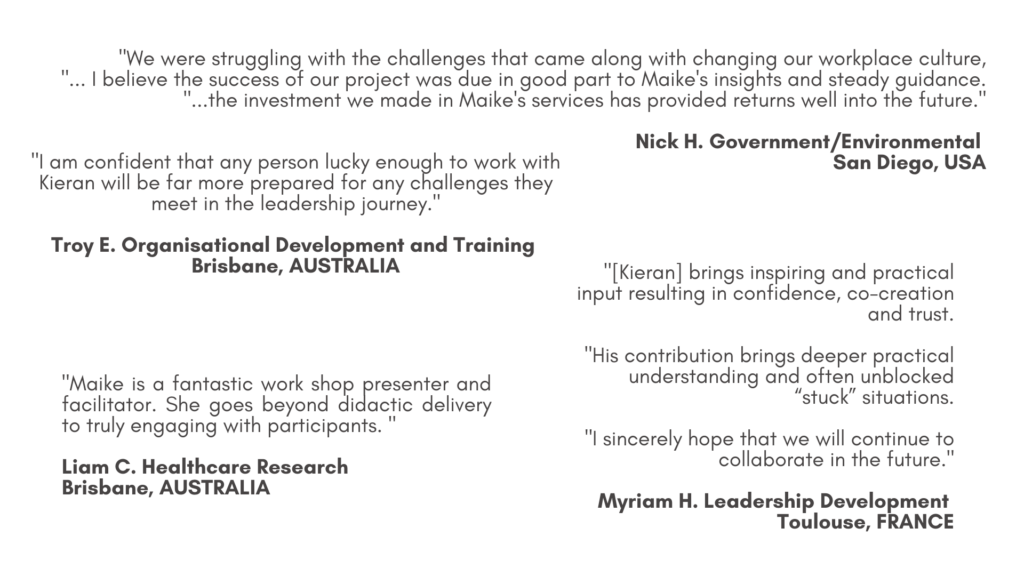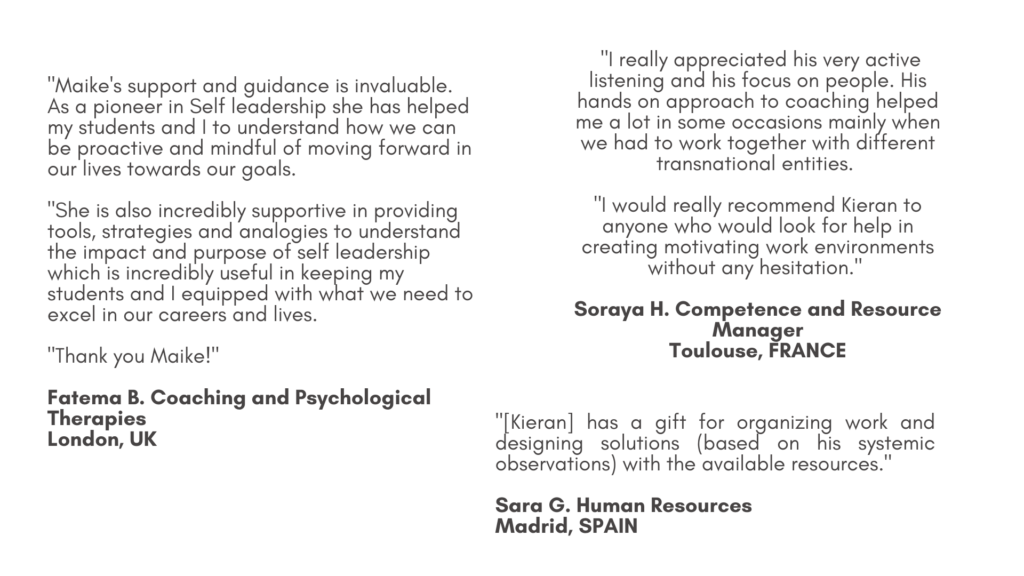WHERE WE HAVE WORKED

Build your skills and confidence across the entire landscape of
ORGANISATIONAL LEADERSHIP
CLICK on a domain to discover what you can do today,
to become the leader you want to be.
People
Engage people with confidence and understanding, and build the trusting environments that encourage growth.
Communication
Communicate with clarity of vision and impart purpose, strategies and actions to teams clearly and accurately.
Leadership
Lead with certainty and courage through easy and tough times; knowing what your team needs and how to give it to them.
Development
Develop people's abilities to perform today and excel tomorrow with skills, knowledge, belief and collective intelligence.
Management
Manage activities with the transparency and accuracy needed to maintain team momentum and customer satisfaction.
Empowerment
Empower people and teams with the culture, support and autonomy to take themselves, the team and the organisation further.
Being a leader is not easy.
You are required to balance the expectations of people above you, your team members, the customers, and sometimes society.
You are expected to have modern leadership styles and skills. You are responsible for driving and managing change. You have performance targets, limitations and pressures. You second guess yourself or think that you'll lose your role. You need to help others overcome their challenges. You are on your own.
How can you do it all and still go home each day without stressing about your performance as a leader?
So, what are your options?
- Do nothing; you’re fine, your team is fine, everyone is happy.
- Buy a book on leadership… and read it.
- Wait for an opportunity to participate on a leadership development program.
- Invest in a formal qualification and build your knowledge of leadership styles, principles and applications.
- Hire someone to help you navigate your challenges and goals.
- START doing something TODAY…
Below you will find the 6 domains that leaders need to master to meet the expectations of our changing world.
What people say


The 6 domains
of great leadership
Discover what you can do today, and start becoming the leader you want to be.
People
Engage people with confidence and understanding, and build the trusting environments that encourage growth.
WHAT YOU NEED TO KNOW
Question: If you wanted to cook food that tasted awesome, had a positive impact on your body and made you feel good, what would you do?
Answer: Well, a good place to start would be to learn about food and how it interacts with your body.
Therefore: If you want to engage people with confidence and understanding, a good place to start is to learn about…
PEOPLE and how they engage and operate.
We are a complex species with a brain full of trillions of synapses that enable us to think, feel and behave. Learning about those functions is simply the logical thing to do.
Let’s take a small step to start with.
WHAT YOU CAN DO TODAY
Step 1: Start observing what you are doing.
Sounds too easy and too simple to be worth doing, doesn’t it? But, without a willingness to actively observe your own thoughts, feelings and behaviour, you will struggle to lead people well.
So TODAY, start observing what you say to people and how you say it; how you feel after speaking with people; how you move, sit or stand; your emotional states throughout the day and even what you think about.
Reflect on what you observe and BRAINSTORM what impacts the things you do may be having on the people around you.
Communication
Communicate with clarity of vision and impart purpose, strategies and actions to teams clearly and accurately.
WHAT YOU NEED TO KNOW
Communication is not a one way street; even if you are the only one talking or writing.
Everything we communicate starts as an idea in our head. Without thinking about it we form a message around the idea. Our message takes shape as words or images or sounds that mean something to us.
And then, something that we are all very good at, we ASSUME that those images, words or sounds mean the same thing to other people.
They don’t. And assumption begets failure.
Communication is CONTINUALLY reported by people as a priority issue needing to be addressed in their teams or organisations.
WHAT YOU CAN DO TODAY
Step 1: Start checking for understanding.
What does that mean?
It means that if you are requesting a door to be painted white, you check what the recipient of that message understands. For example, are they going to paint just the front of the door, when it is closed, in a ‘new’ slightly off-white colour?
So TODAY, start thinking about the language you are using to convey messages to people. Ask yourself if there is any room for assumption in your message. And then, if your really want to step it up, ASK people what they think you meant.
Leadership
Lead with certainty and courage through easy and tough times; knowing what your team needs and how to give it to them.
WHAT YOU NEED TO KNOW
Leading is a behaviour.
Just like reading, speaking, swimming, building and so on. It is a behaviour you CHOOSE to do.
It is also something that takes attention, practice and improvement to do well.
If you were told that tomorrow your job would be to build a house, would you consider yourself a great builder? Probably not.
Yet there are millions of people in leadership roles who are expected to deliver great outcomes without the understanding or capability for the required behaviour.
Every behaviour has a primary focus and outcome. For leadership it is PEOPLE and their SUCCESS.
WHAT YOU CAN DO TODAY
Step 1: Start really getting to know your people.
But you have been working with them for ages, you already know them… don’t you?… Do you?
People are the reason any team or organisation creates any value at all. The quicker you perceive people as the highest priority for your attention the quicker you will lead appropriately.
So TODAY, start with just one person in your team and ask them: “In your dream job…
- What role would you be performing?
- Which strengths would you be using and how?
- What would be challenging for you?
Development
Develop people's abilities to perform today and excel tomorrow with skills, knowledge, belief and collective intelligence.
WHAT YOU NEED TO KNOW
Development focuses on the capabilities, habits and behaviours of individuals and the collective team.
Unfortunately, identifying the relevant starting point for development activities is all too often overlooked.
In order to develop individuals and teams you need to be very clear on what the current capabilities, habits and behaviours are today and, where they need to be tomorrow.
It is the difference between these two points that defines the gap that development activities need to close.
Development is an INVESTMENT in people so that they can create value for the team and organisation.
WHAT YOU CAN DO TODAY
Step 1: Start identifying capability requirements.
Capability is the knowledge, skill and attitude required to perform a role. For example, driving a car needs (among many things): knowledge of road rules and car operation, hand-eye coordination and distance judgment skills, and a focused attitude towards safe driving.
So TODAY, pick a moderate-to-high skill task that you perform regularly. Break that task down into its knowledge, skill, and if you can, attitude requirements.
Reflect on the team to see how many people you think currently hold those requirements. Then, ask team members what requirements they think they hold.
Management
Manage activities with the transparency and accuracy needed to maintain team momentum and customer satisfaction.
WHAT YOU NEED TO KNOW
The word ‘manager’ usually describes a role responsible for a group of people.
However, by management we are referring to the act of managing the ACTIVITIES a team performs. This includes meetings, routine tasks, projects, changes and innovation.
Great leaders must not only lead people, but also manage activities so that the team can succeed.
Today there are multiple management strategies for projects or change that seek to enable effective and efficient conduct of activities. Some common approaches include LEAN, Agile, Kaizen, PMBOK, ADKAR, and 7S.
To get you going in the right direction we can start with some fundamental practices.
WHAT YOU CAN DO TODAY
Step 1: Start assessing current management practices.
What are you doing already to manage the activities of the team? Your practices might include: team meetings, planning, measuring, monitoring, reporting, evaluating, improving, standardising, and fixing to name a few.
So TODAY, start listing the practices you currently employ. Then, from that list start with the 3 most regular or repeated practices and answer the following questions for each one:
- What value does this practice bring and for who?
- What would happen if this practice wasn’t used?
- How do team members rate this practice?
Empowerment
Empower people and teams with the culture, support and autonomy to take themselves, the team and the organisation further.
WHAT YOU NEED TO KNOW
There are 2 varying perspectives of empowerment across industries, organisations and business literature.
From one, empowerment is when employees take ownership of their own strengths, motivation, development, goal setting and search for opportunities to progress.
From the other, it is when the organisation’s culture and leadership behaviours actively develop trust, share power, create opportunities for growth and grant autonomy to their employees.
Which version do we want in our teams?
Both. As a leader you want to create the environment where people can and want to perform; including yourself.
Empowerment is the ultimate combination of organisational leadership cultures and self-leadership behaviours.
WHAT YOU CAN DO TODAY
Step 1: Start understanding the current culture.
Behind organisational culture are the shared beliefs, values, biases, traditions, accepted norms and attitudes of a group of people.
Culture defines the terms for acceptance in a group, and guides workplace behaviours, often unconsciously.
So TODAY, start identifying the obvious culture components within your team. These could include:
- the level of willingness to trust each other,
- the level of decisions an individual can make on their own,
- how accessible are development opportunities,
- what happens when someone makes a mistake,
- the level of acceptance for diverse personalities and character traits.

